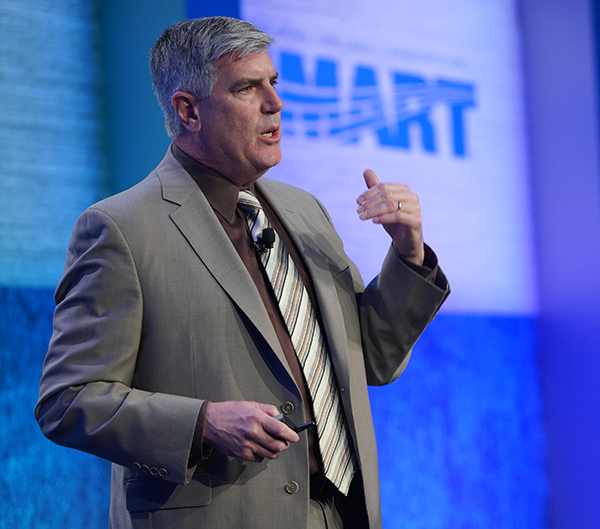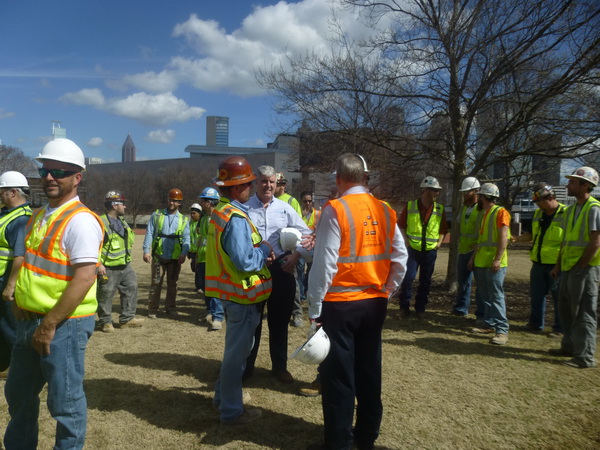
SMART General President Joe Sellers speaks at the 2018 Partners in Progress Conference.
A second-generation worker in the sheet metal industry, Joe Sellers took over in 2015 as general president of the International Association of Sheet Metal, Air, Rail and Transportation Workers, the labor union commonly known as SMART. The union represents roughly 216,000 workers in the various industries across North America, ranging from construction and production to welders and bus operators.
Sellers’ priorities at SMART have included key issues for membership such as pensions, health care and apprenticeships. Additionally, he has implemented measures to upgrade the union’s continuing education programs and professional skills training.
SMACNA recently spoke with Sellers about some of SMART’s latest developments. Sellers says adapting to rapidly evolving technological advancements and improving workforce forecasting techniques are among the union’s top objectives at the moment.
There are a lot of forces at work in this industry with a lot of moving pieces. Things like technological advancements, workforce recruitment, aging demographics, jurisdictional disputes and non-union competition. How do you focus on them all?
.jpg)
Joe Sellers (center) talks with SMACNA contractors during the Labor Forum at SMACNA’s 2018 Annual Convention
Joe Sellers: We break that down. We break it down by department, we break it down by staff assignment. We take a team approach. In 2018, we revisited our departments and broke down the responsibilities within them as well as within the staff.
We created a matrix of who was an owner of a particular task; who is accountable for that particular task; and what are the downstream responsibilities and reporting processes for each one of our staff or even local unions that may be reporting up the ladder on a particular issue.
We continue to hone that accountability, that ownership of a project. We also conduct meetings with local unions. We’re always trying to keep in touch with what's going on out in the field. We have regular conference calls by region to make sure that whatever the issues are, whether it's a workforce development issue or a technology issue, or some other issue, that our team is engaged in that process.
Let's talk a little bit about technology. There seem to be some exciting technological advances coming into the market. How do you make sure union contractors and skilled craftsman are best positioned to take advantage of the technologies available to them?
Sellers: As you know, this is and will continue to be an ever-changing industry. We like to meet and talk with our stakeholders, customers, owners, and ask them what they are seeing.
I do what's called a listening tour. When I go in to different towns and cities, I try to go into our shops there. I try to go onto our job sites, or I try to go develop a relationship with a contractor. For example, I recently learned one of our contractors is doing amazing things with drones and drone technology that I wasn't aware of.
.jpg)
Joe Sellers (center) meets with members of Sheet Metal Workers Local 63 at Kleeberg Sheet Metal Inc. in Ludlow, Massachusetts.
As an industry, we develop differently. Some shops develop more quickly in technology and some take a little bit of time to do that. One of the things that we try to do is develop a sound foundation. You can't always train to the specifics of individual platforms, but you can train to establish a foundation of understanding and knowledge.
iTi is a powerful tool that can help train and retrain members. How do retraining and the evolving skill sets in the workforce fit within your approach to technology?
Sellers: It's vital to have continuing education. We attend trade shows, so we get around and we see what's going on. We'll then debrief at a staff meeting about what we learned.
Taking that information and providing it to iTi and our training centers is really important. Where is the industry heading? What is coming out? What do we see coming up in the next couple years?
We've also developed a technology committee that will update iTi about what we're seeing. Technology is changing so rapidly, we need to make sure that we’re on top of it as best we can.
We also do other delivery modules. We changed our curriculum around. We have an electronic curriculum, and hopefully by this upcoming apprentice class in September, we'll be able to disseminate our material in a different fashion electronically. As that first-year class comes in, we're going to be meeting the needs of those students. We’re making sure they're receiving information the way they're accustomed to receiving information today, not the way it was 10 years ago.
Looking at workforce development, there may not necessarily be labor shortages in every market, but some need more recruitment than others. How do you tell when a market's in need, and what kind of action plans do you implement when you do make that determination?
Sellers: We as an industry need to forecast better, I believe, so as we can project the mobilization of job changes on a regular basis. If we have the fundamentals down, we can get an idea of where the workforces are going to be and what skillsets are going to be required for a particular region.
Also how do we apprentice the industry, not just for today in 2019, but how do we apprentice the industry for 2021 and 2022 so that we're meeting those needs down the road?
There are certainly hotspots in the country. We've had regular calls with different regions to get an understanding of the amount of industrial work that's going to be there. We try to project what we think is the work skill level and how that mobilization schedule will change.
For instance, there are a lot of welding needs right now. A welder isn’t going to wait around for a project, so we have to be strategic in how we use the workforce that's available and how we keep them busy on particular projects. Labor and management at the local and national levels also know they’re responsible for making sure that we're out there recruiting people for our industry.
About 90 percent of first-year apprentices said they heard about the opportunity through friends and family, according to a recent survey by the Best Practices Task Force. Is there a way to leverage the strong word of mouth even further?
Sellers: That’s what has changed over so many years. I came from a working-class neighborhood, so each one of us was striving to get into a labor union. That dynamic has changed, and we're trying to keep that same mentality. That's a labor and management goal we should have.

Joe Sellers (center) visits with R.F. Knox and Crown Corr employees in Atlanta, members of Sheet Metal Workers Local 85.
We have really increased our recruitment and retention opportunities. We’ve developed new recruitment videos. As a matter of fact, iTi recently launched a new video focusing on women in the trades. Women in the trades have had a large increase over the last several years.
We're also in the process of implementing virtual welders. You can go to any trade show or any school and use the virtual welder to help recruit and retain people. They can put on a pair of goggles or a hood and then see how everything is done virtually. We also have virtual lift programs, so you can get on a work lift and go up 80 feet and really feel what it is like to work in that environment.
We need to make sure people see the industry has a future for them.
What are your priorities for a SMACNA-SMART partnership over the next several years?
Sellers: You said the word, “partnership.” Labor and management working together.
I continue to meet with (SMACNA CEO) Vince Sandusky on a regular basis to try to figure out what’s on our agendas. We may not always agree, but we equally understand the issues that have popped up on our radars since our last meeting. That partnership is important.
The important thing with that continued partnership is growth. Capturing every job, capturing every opportunity that we possibly can within our range. Figuring out our plans, both locally and nationally. What can we do to help the industry grow so that we can improve our market share?
How do we encourage two-way communication with our members? We’re really good at a national level when it comes to disseminating information down the ladder. But we need to get that information back up the ladder, and that’s vital to accomplishing a lot of these goals – listening, getting out there and touring shops and job sites. We really need to see what's going on in the workplace and how technology is going to advance in the future.